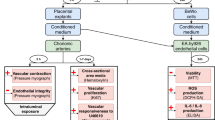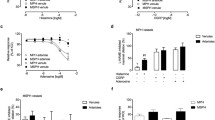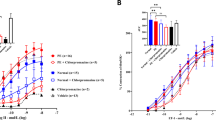Abstract
It has been recently hypothesized that in PIH a placental oxidant-antioxidant imbalance might cause the release of lipoperoxidation products into the circulation, with subsequent damage of endothelial cell membranes. In this hypothesis the endothelial cell and further increase in circulating lipoperoxide levels, which are by themselves able to induce smooth muscle constriction and increased pressor responsiveness to angiotensin II. In order to investigate this issue, we studied the basal content of lipid peroxides in terms of malondialdehyde (MDA) in the syncytiotrophoblast plasma membranes (SPM) from PIH women. Moreover, we investigated the susceptibility to peroxidation of SPM using anin vitro oxidative stress as a tool to verify the predisposition to thein vivo development of peroxidation products. The fatty acid composition of the membranes was also analyzed. Microvillus membrane lipoperoxide concentrations were significantly increased in PIH women (62.8±7.6 ng MDA/mg prot) compared with healthy pregnant subjects (37.6±4.8 ng MDA/mg prot; p<0.01).
The formation of TBARS under the action of phenylhydrazine was significantly greater in PIH women (90.3±7.4 mmol MDA/mol cholesterol) than in normal pregnant subjects (68.6±6.4 mmol MDA/mol cholesterol; p<0.01). In PIH microvillus membrane we also observed a significant increase of the content of polyunsaturated arachidonic acid.
The increased susceptibility to oxidative stress of SPMs from PIH women might be due either to reduced antioxidant systems or to an abnormality of the lipid composition of the membrane. The present work also demonstrated in PIH a reduction in the SPM content of saturated fatty acids with an increase in polyunsaturated fatty acids, which are the major substrate for peroxidation. On the other hand, the higher lipoperoxidation may be due to the observed increased susceptibility to peroxidative stress, to a primary reduction in placental perfusion with tissue hypoxia or to both factors, which can potentiate each other.
Similar content being viewed by others
References
Lunell NO, Lewonder R, Mamoun I, Nylund L, Sarby S, Thornstrom S: Uteroplacental blood flow in pregnancy induced hypertension. Scand J Clin Lab Invest 44 (suppl. 169):28–35, 1984
Ramsey EM, Donna MV: Placental vasculature and circulation. Philadelphia, Pennsylvania, WB Saunders, 1–101, 1980
Yoshikawa T, Furukawa Y, Wakamatsu Y, Takemura S, Tanaka H, Kondo M: Experimental hypoxia and lipid peroxide in rats. Biochem Med 27:340–342, 1990
Mazière JC, Salmon S, Santus R, Candide C, Reyftmann JP, Morlière P, Mazière C, Dubertret L: Lipid peroxidation and cellular function:in vitro model sand relation toin vivo observations. In: Molecular biology of atherosclerosis, MJ Halpern (Ed.) John Libbey & Company Ltd, 327–339, 1991
Loeper J, Goy J, Bedu O, Rozensztayn L: Lipid peroxidation and protective enzymes during the course of myocardial infarction. Agents Actions 22:340–342, 1987
Aznar J, Santos MT, Valles J, Salla J: Serum malondialdehydelike material (MDA-LM) in acute myocardial infarction. J Clin Pathol 36:712–715, 1983
Goto Y: Lipid peroxides as a cause of vascular disease. In: Lipid peroxides in biology and medicine. Yagi K (Ed.) New York, Academic Press Inc 295–303, 1982
Stringer MD, Gorog PG, Freeman A, Kakkar VV: Lipid peroxides and atherosclerosis. Brit Med J 298:281–284, 1989
Mc Cord JM: Oxygen derived free radicals in postischemic tissue injury. N Engl J Med 312:159–163, 1985
Maseki M, Nishigaki I, Hagihara M et al.: Lipid peroxide levels and lipid content of serum lipoprotein fractions of pregnant subjects with or without pre-eclampsia. Clinica Chimica Acta 115:155–161, 1981
Wickens D, Wilkins MH, Lunec J: Free radical oxidation (peroxidation) products in plasma in normal and abnormal pregnancy. Ann Clin Biochem 18:158–162, 1981
Davidge ST, Hubel A, Brayden RD, Capeless EC, McLaughlin MK: Sera antioxidant activity in uncomplicated and preeclamptic pregnancies. Obstet Gynecol 79:897–901, 1992
Wang Y, Walsh SW, Guo J, Zhang J: The imbalance between thromboxane and prostacycline in preeclampsia is associated with an imbalance between lipid peroxides and vitamin E in maternal blood. Am J Obstet Gynecol 165:1695–1700, 1991
Wisdom SJ, Wilson R, Mc Killop JH, Walker JJ: Antioxidant systems in normal pregnancy and in pregnancy-induced hypertension. Am J Obstet Gynecol 165:1701–1704, 1991
Hubel CA, Roberts JM, Taylor RN et al.: Lipid peroxidation in pregnancy: new perspectives on preeclampsia. Am J Obstet Gynecol 161:1025–1034, 1989
Shennan BD: Recent advances in placental ion transport. Biochem Physiol 101:187–193, 1992
Cester N, Mazzanti L, Benedetti G, Cugini AM, Rabini RA, Tranquilli AL, Valensise H, Romanini C: Pregnancy induced hypertension: Observation on chemical-physical properties of syncytiotrophoblast plasma membranes from human placenta. Clin and Exper Hyper in Pregnancy B7:57–66, 1988
Mazzanti L, Rabini RA, Cester N, Romanini C, Bertoli E: Transmembrane cation transport: an approach to the study of the molecular basis of hypertension. In: Molecular basis of membrane-associated diseases, Azzi A et al. Eds, Springer-Verlag Berlin, 129–133, 1989
Chen JW, Zhang L, Lian X, Hwang F: Effect of hydroxyl radical on Na+, K+ ATPase activity of the brain microsomal membranes. Cell Biol Int Rep 16:927–936, 1992
Davey D, MacGillivray I: The classification and definition of the hypertensive disorders of pregnancy. Am J Obstet Gynecol 158:892–898, 1988
Whitsett JA, Wallick ET: H3 ouabain binding and Na+-ATPase activity in human placenta. Am J Physiol 238:E38-E45, 1980
Lowry OH, Rosemburg MY, Farr AL, Randall R: Protein measurement with the Folin fenol reagent. J Biol Chem 193:265–275, 1951
Zak B: Simple rapid microtechnic for serum total cholesterol. Am J Clin Path 27:583–588, 1957
Bartlett GR: Phosphorus assay in column chromatography. J Biol Chem 234:466–468, 1956
Yagi K (Ed.): Assay for blood plasma or serum. In: Yagi K, Ed. Lipid peroxides in biology and medicine, Yagi K (Ed) Academic Press, New York, 223–228, 1982
Alcindor LG, Antebe H: Determination of LDL susceptibility to oxidation. In: Molecular biology of atherosclerosis, Halpern MJ (Ed.) John Libbey & Company Ltd, London, 383–388, 1991
Diamant S, Kissilevitz R, Diamant J: Lipid peroxidation system in human placental tissue: general properties and the influence of gestational age. Biology of Reproduction 23:776–781, 1980
Roberts JM, Taylor RN, Musci TJ, Rodgers GM, Hubel CA, McLaughlin MK: Preeclampsia: an endothelial cell disorder. Am J Obstet Gynecol 161:1200–1204, 1989
Sasaki T, Wakai S, Asano T, Watanabi T, Kirino T, Sano K: The effect of a lipid hydroperoxide of arachidonic acid on the canine basilar artery. J Neurosurg 54:357–365, 1981
Gurtner GH, Knoblanch A, Smith PL, Sies H, Adkinson NF: Oxidant and lipid induced pulmonary vasoconstriction mediated by arachidonic acid metabolites. J Appl Physiol Respir Environ Exercise Physiol 55:949–954, 1983
Author information
Authors and Affiliations
Rights and permissions
About this article
Cite this article
Cester, N., Staffolani, R., Rabini, R.A. et al. Pregnancy induced hypertension: a role for peroxidation in microvillus plasma membranes. Mol Cell Biochem 131, 151–155 (1994). https://doi.org/10.1007/BF00925951
Received:
Accepted:
Issue Date:
DOI: https://doi.org/10.1007/BF00925951




